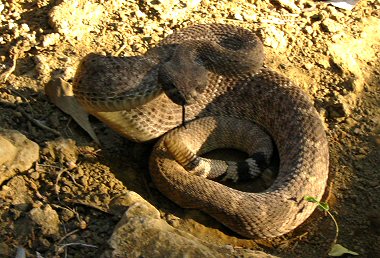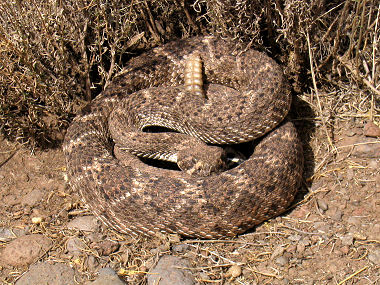| |
Diamondback Rattlesnake
 |
 |
 |
|
|
| If you do any amount of hiking in the
Sonoran Desert, you will most certainly encounter a rattlesnake or two.
These fascinating creatures occupy a valuable niche in the environment
and deserve our respect. They are also a reminder and symbol of the
wilderness experience you are seeking. To paraphrase Ed Abbey -
'Wilderness is big animals that can eat you'. This doesn't exactly apply
in this case since rattlesnakes do not eat people (how would it get its mouth around
your big head?), but you get the idea. Rattlesnakes are generally shy
and fearful of humans and will not strike unless provoked. If you see a
rattlesnake, consider yourself lucky. Maintain a safe distance (a snake
can strike a distance of up to two-thirds of it's body length, if you
maintain at least one body lengths distance you will be ok) step around
it, and continue on your way. |
| |
 |
Distinguishing
Features |
 |
|
I don't know, the rattle maybe?!? Certainly the rattle is the easiest way
to identify a rattlesnake. Even a baby rattlesnake has the first segment
of a rattle, called a 'prebutton'.
 The prebutton is lost the
first time
the snake sheds it's skin and is replaced by a button. Each time a snake
sheds it's skin, a new segment is added to the rattle. A snake may shed
it's skin 1-4 times per year. The prebutton is lost the
first time
the snake sheds it's skin and is replaced by a button. Each time a snake
sheds it's skin, a new segment is added to the rattle. A snake may shed
it's skin 1-4 times per year.
|
Half of all rattlesnake bites in the US
occur because people purposefully interact with the snakes. |
It is a myth that you can tell the age of
a snake by the counting the number of rattles on its tail. The tail will
only rattle when there are two or more segments (a baby rattler will
shake it's tail, but it will produce more of a buzzing sound). The
rattle is composed of keratin (the same stuff that makes up your finger
nails). There is nothing inside the tail to make the noise, the sound is
produced by the loose segments vibrating against one another.
Interestingly enough, a rattlesnake can vibrate its tail at a rate
greater than 60x per second. Scientists have found that the muscle
fibers in the rattlesnakes tail are the fastest firing on the planet.
Other distinguishing features of the snake include its triangular shaped
head (very cool in my opinion), ridges over the eyes, and heat sensing
pits (called loreal pits) in the front of its face (though if you
can see these pits you're probably too close!). |
| |
 |
Diet |
 |
|
| Rodents (squirrels, mice and rabbits)
make up the bulk of a rattlesnakes diet, though they also
consume lizards and birds. Rattlesnakes use venom (basically toxic
saliva) to capture prey. The venom is injected through hollow fangs
(like hypodermic needles). Snake venoms are complex, consisting of
proteins that range from hemotoxins (which break down cells and tissue)
to anticoagulants and neurotoxins (may cause circulatory arrest or
respiratory paralysis). The snake hunts by lying in wait for a rodent to
wander by. It then strikes and retreats, waiting for its prey to succumb
to the venom. It then uses its heat sensing organs to locate its meal. |
| |
 |
Natural History |
 |
|
Several different types of rattlesnakes live in the Sonoran Desert, most
notable are the: western diamondback
rattler,
the Mohave rattlesnake, the tiger rattles nake, the black tail rattlesnake
and the sidewinder. Rattlesnakes are most active at nights during the warmer
months, and during the day in spring and fall. The snake typically
hibernates during the colder winter months (often in a pack rat burrow,
after eating or evicting its inhabitant), but may come out on warmer
days to bask in the sun. Baby rattlers are typically born in late
summer. They may have up to 22 other siblings, are 9-14 inches long and
come equipped with fully functional teeth and venom (isn't that cute?
... ootchie..kootchie...koo). nake, the black tail rattlesnake
and the sidewinder. Rattlesnakes are most active at nights during the warmer
months, and during the day in spring and fall. The snake typically
hibernates during the colder winter months (often in a pack rat burrow,
after eating or evicting its inhabitant), but may come out on warmer
days to bask in the sun. Baby rattlers are typically born in late
summer. They may have up to 22 other siblings, are 9-14 inches long and
come equipped with fully functional teeth and venom (isn't that cute?
... ootchie..kootchie...koo).
|
Back to Flora & Fauna |
|

